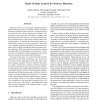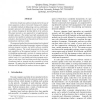142 search results - page 7 / 29 » Program obfuscation: a quantitative approach |
ACSAC
2007
IEEE
14 years 1 months ago
2007
IEEE
Malicious code is an increasingly important problem that threatens the security of computer systems. The traditional line of defense against malware is composed of malware detecto...
CF
2009
ACM
14 years 2 months ago
2009
ACM
The exponential growth of databases that contains biological information (such as protein and DNA data) demands great efforts to improve the performance of computational platforms...
ACSAC
2007
IEEE
14 years 1 months ago
2007
IEEE
Detection of malicious software (malware) by the use of static signatures is often criticized for being overly simplistic. Available methods of obfuscating code (so-called metamor...
BMCBI
2006
13 years 7 months ago
2006
Background: The ever-expanding population of gene expression profiles (EPs) from specified cells and tissues under a variety of experimental conditions is an important but difficu...
TSE
2008
13 years 7 months ago
2008
Buggy software is a reality and automated techniques for discovering bugs are highly desirable. A specification describes the correct behavior of a program. For example, a file mus...


